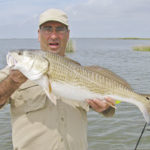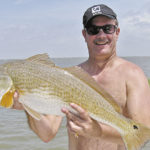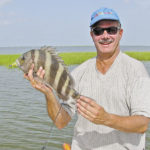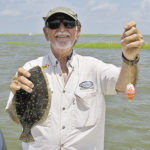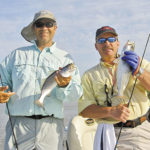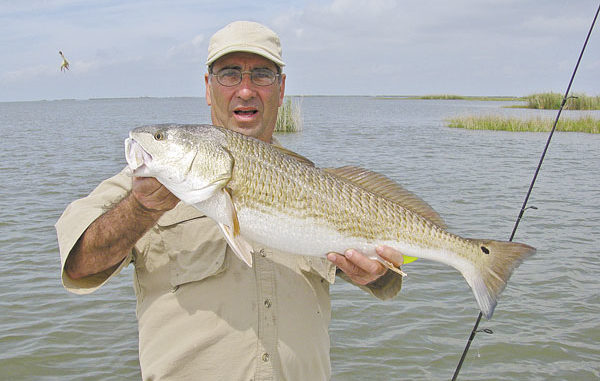
Think this is a transition month? It isn’t for grilling-sized redfish in this perennial hotspot.
Except for the red life-vests and yellow hard-hats on the passengers, it mighta been a party barge on the Tickfaw, Tangipahoa or Tchefuncte on a Sunday afternoon. Actually, those party-bargers get more exercise, their arms at least, while “bending elbows,” as the saying goes. All hands (and elbows) on this deck appeared idle, and had been the whole while we watched.
Eddie had been marveling at their “exertion” for almost two hours as they putted around within a quarter mile of us near the western edge of Bastian Bay. Meanwhile, we cast, cursed and flipped off hardheads and gaftops — or watched ladyfish cartwheel and throw our jigs. Our box was “crammed” with a grand total of two barely legal school specs, one 16 and 1/100000000000-inch puppy drum and a flounder that best-belonged in a five-gallon saltwater aquarium.
Eddie finally yanked up his anchor, cranked up the outboard and headed toward the (apparent) VOO barge. At 50 yards, he hauled back on the throttle, and started idling his boat toward the vessel, his mouth smirking, his eyebrows dancing and his eyes gleaming in a manner we’d noticed (with alarm) many times before. Take his famous wedding reception.
Eddie’s first marriage lasted three months — which was exactly 89 days and 22 hours longer than I expected his life to last as he started screaming: “Hey! How do WE sign on!” to the gentlemen on the barge. “Man! I want ME one a dem JOBS!” Eddie roared with an exaggerated accent.
Give it to Chris, who tried one of the stupidest things you can pull in a situation like this — reasoning with Eddie.
“Come on, Eddie,” Chris leaned over and rasped close to his ear. “Man, it ain’t THEIR fault there’s no oil to clean up? I mean, would YOU give up $17 an hour for cruising around on a party barge all day?”
“Shooooot!” Eddie laughed and flapped his hand. “That’s chicken feed! Shoulda seen MY hourly rate!”
This weekend Eddie was celebrating the anniversary of his first disbarment and second divorce. Thus his spanking-new cooler held a hefty Thermos of Bloody Mary — half gone.
Not 10 feet from making contact, the barge “workers” scurried to the rail with arms outstretched, hoping to ameliorate our impact. Eddie jammed his boat in reverse just in time. Then he pointed toward the “work” barge and his face furrowed.
“Mind if I have a look at that little cooler!”
We looked over and — whoops! — the little Playmate on the bench next to the red-vested gentlemen INDEED looked familiar.
“The chintzy blowhard didn’t even scratch off the name!” Eddie leaned down and laughed, as the “work” crew grabbed his boat’s railing.
No sooner had he backed his boat trailer into his driveway the previous Saturday (smiling and waving to his glowering neighbors in his strict “NO BOATS ALLOWED IN THE DRIVEWAY!!!” neighborhood) than Eddie got out, waved to his neighbors again, clambered into his bay boat and started yelling. “My COOLER! Where’s my freakin’ cooler!”
“Probably flew out the boat,” Pelayo advised. “After 30 years, you’d think you might notice that such things HAPPEN, especially when you leave stuff loose in the boat for the ride home! Geeez! What are all those bungee cords for!”
And indeed, any enterprising merchant could fully restock his outdoor store every week by simply scavenging the road shoulder from Venice to Belle Chasse.
The inadvertent “throws” from this boat parade litter the Highway 23 roadside almost like beads on Canal Street after Endymion. At any rate, an enterprising clean-up worker had apparently made the find, and put the item to excellent use, it seemed to us.
“ Come on, man,” Pelayo told Eddie. “You’d rather have the thing run over and smashed into a million pieces? Looks like that wino put it to good use. Thank him, and let’s get outta here and go find some fish. Tide’s starting to drop, and the fish will be turning on like clockwork. “
The wino lifted the Playmate and extended it.
“This yours?” he wheezed.
“We found it by the highway last week,” rasped another wino, “right by the place we staying, but heck man, if you … .”
“Let’s go fish, Eddie!” Chris said while yanking him by the shoulder. “You already got a new Playmate — let’s go fish. Tide’s dropping — look!”
He pointed toward the popping cork he’d lost a few minutes before, which was now drifting Gulf-ward amidst the ripples.
“Naw,” Eddie waved at the winos. “Looks like it’s in good hands. But y’all oughta bring some fishing poles out here with ya. … Have a good one.”
We waved, the winos waved back and Eddie slammed the boat into reverse. Soon we were on plane blazing over the shallows of the eroded marsh bordering Grand Bayou.
In brief, the type of fishing available 10 to 20 years ago from, say, the Empire Canal east toward Bayou Grand Laird and Red Pass, is now available west of the Empire Canal — roughly from it to the Lake Washington, Lake Robinson areas south of Port Sulphur.
The marsh east of the canal almost completely vanished. No English Bay. No Bay Crapaud. No Cyprien or Scofield. No Chicharas, Skipjack, Pomme d’ Orr bays anymore. They just “ain’t dere no more.” And the marsh just to the west of the canal is going fast, but in the process of going it provides some dynamite fishing, especially for reds.
You can still get into the specks over the oyster reefs in what used to be English Bay, Scofield, etc. But for redfish, there’s no shoreline left in that area. Hence our shift slightly westward.
Honest geologists have found that the horrific erosion in this area results from sinking land that results from a geologic fault line appropriately dubbed the Empire-Bastian Bay fault. This line extends westward toward Golden Meadow, where similar horrific erosion occurs.
This fault line is the cause of much rage and anguish among greenie scientists — not so much the horrific erosion but rather the dilemma that they can’t blame it on the oil companies. Indeed, here’s the earth goddess in all her glorious beneficence, at work perfectly naturally.
You encounter the same type of rage and anguish during some domestic mishaps and calamities. Prove to your wife — and beyond the slightest doubt — that you in no way contributed to the domestic mishap or calamity in question, indeed that you endeavored in every manner humanly possible to prevent the mishap or calamity, and you dig yourself into a much deeper hole.
Oh, it just BURNS HER UP! Not so much the mishap or the calamity, but that she can’t blame it on YOU! Same thing with greenies and this fault-line erosion.
Sadly, the marsh is going fast around Grand Bayou too. But there’s still enough marsh to fish. And the sad — or bittersweet — part is that an eroding marsh is actually GOOD for fishing, especially for reds, whose top food item are crabs, especially the juvenile ones that hide out in the grass and crevices of an eroding marsh. A high tide lets the reds enter these areas, where they can root around, snatching the little morsels up, along with the cocahoes that hang around in this grassy stuff too. A high and dropping tide is ideal.
Those blustery southeast winds that often rage for days during September had pushed up the tide creating the conditions we crave for redfishing. Soon we turned into the remnants of a pipeline canal, little tufts and lines of marsh grass the only evidence of the former spoil bank.
On a falling tide, you’ll note the ripples and current lines that form between these little remnant-of-spoil-bank islands. For us it’s a no-brainer to anchor — not to wiz through with a trolling motor and make a couple casts with spinnerbaits or gold spoons, but to ANCHOR and work the area over well with shrimp-tipped chartreuse or white beetles 2 feet under popping corks. Sometimes the reds take a little while to appear. You may have spooked them while approaching.
The water was gorgeously murky, normal for this area. Given our preference for cork-fishing, too-clear water often skunks us. Maybe the reds see us better that way? Whatever. We always do better on high tides and murky water for reds.
Despite its attraction to hardheads, we find deceased shrimp helpful for this type of fishing. Sheepshead, drum, flounder and, yes, redfish are more likely to hit a shrimp-sweetened plastic offering of whatever shape or color.
We zeroed in, as always, on the windward side of the eroded island. Just as importantly, the depth finder showed almost 2 feet — perfect. Much shallower, and no sizable reds would be around. Much deeper, and they’d also be scarce (at least in our experience). This spot had rat reds, puppy drum and sheepshead written all over it.
My cork hit the water first, about 2 feet from the grass, and immediately a slight current started pushing it along, a good sign. I turned to watch Pelayo’s cast almost yank Eddie’s ear off when I felt the jerk.
“THAT’S HIM!” Chris yelled at me.
My cork had indeed plunged, and even before my first pop. I reared back, and it was off to the races.
“WOW!” was all Eddie could manage while scratching his ear and watching my spool empty, and the wake barreling along the grassline.
“He’s turning!” I roared. “He’s turning to the open water! He’s gotta be a monster!”
“Monster hardheads and sailcats do that too,” Pelayo smirked.
“This ain’t no hardhead, podnuh! Look at that!”
And I waved my bowed rod in front of his face.
“And LISTEN to that!”
I put my spool inches from his ear.
“Alright, alright!” Pelayo yelled right before he struck back himself. “And this ain’t no hardhead EITHER. WHOO!!”
Pelayo’s pole was high overhead as he cranked furiously.
“What the … ?” he suddenly frowned. “Did he get off?”
Pelayo’s pole and line went slack, as he cranked the reel.
“HECK NO!” I yelled. “He’s swimming in ON YA! He’s a monster red too, headin’ for the open water!”
Just as Pelayo reeled in the slack, his reel gave a mighty screech to prove my point — and the rod was almost jerked from his grasp.
“Oh YEAH!” he beamed while looking over. “Feels like a red alright!”
I was still savoring mine. His berserk run took him back and forth in front of the boat, as I gained — then lost — line. I held my pole high overhead and bellowed my joy to the heavens, just as he exploded in a froth of bubbles and copper.
“Eight-pounder for sure!” I raved as he barreled off on another run, and I felt the muscles in my forearms bunching up from the strain of the battle.
“Forget it Eddie!” I said in a rare moment of magnanimity while watching him reach for the net. “I can net mine myself. Go get yourself one! They’re stacked up along that current line. Between the islands.”
Eddie smiled, as his shrimp-tipped green beetle 2 feet under a cork headed shoreward.
I was just dipping the net under my red when Eddie erupted.
“Whoo! Yeah!” He had a crazy look on his face as a wake streaked across the shoreline and plunged into the flooded grass itself.
“Work him out, Eddie!” Pelayo counseled. “Work him outta that grass so he won’t cut the line!”
And Eddie tightened his drag a bit.
“THERE!” Eddie beamed. “Got him out!”
Now his fish streaked for the open water too. This spot yielded four reds, two drum and a flounder before petering out. That’s the thing with this type of fishing. You never really find MASSIVE schools in any one place. But you find enough fish and enough variety to make for an action-packed trip.
The next spot had a nice current too — but a little too nice. The cork barreled across the point too fast. Pelayo’s cork suddenly stopped and started sinking slowly.
“Caught the bottom,” he frowned while reeling in the slack. Then — “Whoa!”
The water blew up.
“Flounder,” Pelayo beamed, “doing his little head-shaking, mouth-rattling bit!”
Indeed, soon the smallish (but delicious) flatfish was flapping in the box. Rather than a stalker like the speck and red, the flounder’s an ambusher. He lies in wait, allowing the current to bring prey within range. These current-washed points serve as his food plot.
We nailed another rat red and another puppy drum, then I noticed a tern smacking the water around the little eddies formed by the outgoing current about a hundred feet behind the boat — away from the shore. I cast towards the commotion.
A little rip had formed from the falling tide as the clear water dropping from the upper marshes and ponds clashed with the murkier, wave-churned water that had entered from the Gulf with the high tide. An offshore rip generally means fish. An inshore rip means much the same.
“We’re on ‘em! Yessir!” Pelayo, who beat me to the cast, was already yelling.
Then his trout hit the surface in a gill-rattling frenzy. I cast out right next to him, and we both hauled in 15-inch specks.
“Get it out there Chris and Eddie!” I whooped. “They’re turned on!”
Chris’ cork plunged on its third pop, then the school speck blew up on the surface. During the next half hour, we caught school trout on about every second cast. Chartreuse beetles seemed the ticket (with or without shrimp), though they smacked my shad rigs with equal gusto.
Next we hauled in two 15-9/10-inch rat reds, and pulled up the anchor. Next spot was another grassy point, with murky water, a wind-lapped shoreline and the added bonus of an oyster bottom — which we discovered with the propeller.
Eddie cranked in a nice sheepshead on his first cast. Then a red. Then Pelayo and Chris each caught gorgeous reds.
We ended the day with 13 reds (far from a four-man limit), six puppy drum, five sheepshead, two flounder, and a dozen school specks. For us, an immensely successful and enjoyable outing.
